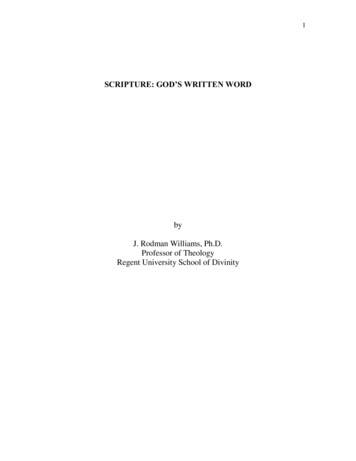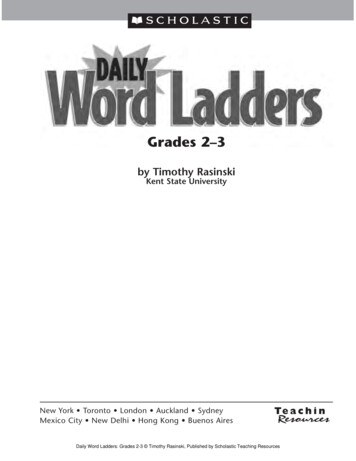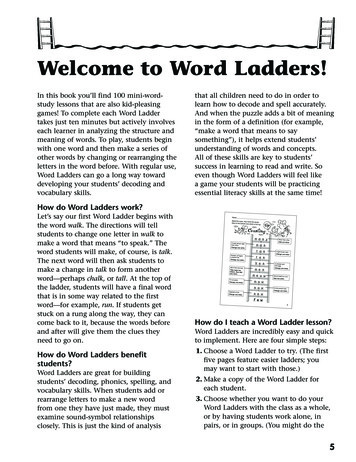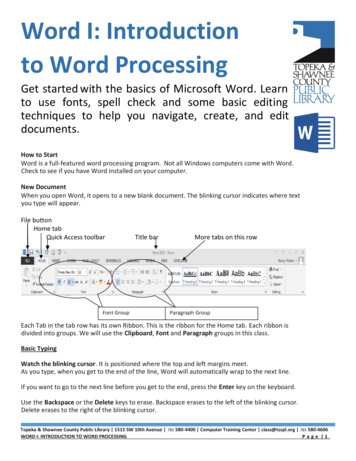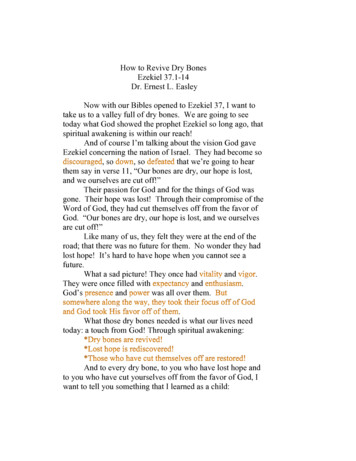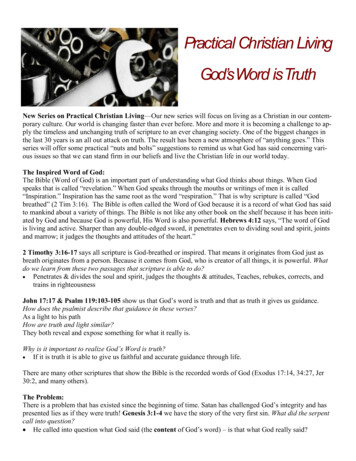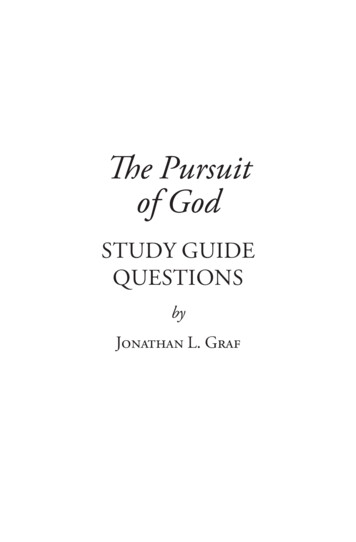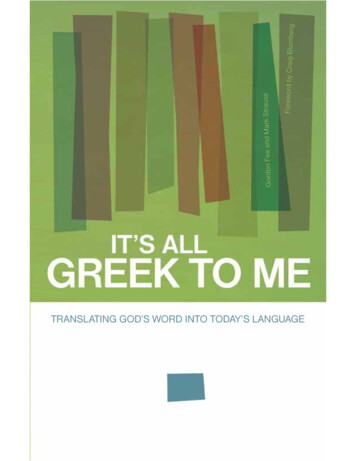
Transcription
TRANSLATING GOD’S WORD INTO TODAY’S LANGUAGEForeword by Craig BlombergGordon Fee and Mark Strauss
TRANSLATING GOD’S WORD INTO TODAY’S LANGUAGEGordon Fee and Mark StraussForeword by Craig BlombergInternational Bible Society
The purpose and passion of International Bible Society is to faithfully translateand reach out with God’s word so that people around the world may becomedisciples of Jesus Christ and members of his body.To receive a free catalog featuring hundreds of Scripture ministry products,contact International Bible Society:In US and Canada:Phone: 800-524-1588Internet: IBSDirect.comFax:719-867-2870E-mail: IBSDirectService@ibs.orgMail:1820 Jet Stream Drive, Colorado Springs, CO 80921-3696It’s All Greek to MeAdapted from How to Choose a Translation for All Its Worth: A Guide to Understanding and Using Bible Versions Copyright 2007 by Gordon D. Feeand Mark L. Strauss (Grand Rapids: Zondervan, 2007). Used by permission.1820 Jet Stream Drive, Colorado Springs, CO 80921-3696Eng. Booklet-3006IBS09-10000ISBN 978-1-56320-493-73/09Printed in U.S.A.
ContentsForeword . 1Part OneBible Translation: Why? What? How? . 3The Why of Bible Translation . 3The What of Bible Translation . 4The How of Bible Translation. 5Part TwoWhat Makes for Excellence in Bible Translation? . 6Two Approaches to Translation: Form or Function? .7Which to Choose?. 9All Translation Is Interpretation .11Isn’t That Just a “Paraphrase”? .13Original Meaning and Contemporary Relevance .14The Goals of Formal, Functional,and Mediating Versions .15Translation and the Doctrine of Inspiration .16Standards of Excellence in Translation .18Conclusion .23
TranslationsAmerican Standard Version (ASV)Contemporary English Version (CEV)English Standard Version (ESV)God’s Word (GW)Good News Translation (GNT)Holman Christian Standard Bible (HCSB)Jerusalem Bible (JB)King James Version (KJV)Living Bible (LB)The MessageNew American Bible (NAB)New American Standard Bible (NASB)New Century Version (NCV)New English Bible (NEB)New English Translation (NET)New International Version (NIV)New Jerusalem Bible (NJB)New King James Version (NKJV)New Living Translation (NLT)New Revised Standard Version (NRSV)Revised English Bible (REB)Revised Standard Version (RSV)TanakhToday’s New International Version (Today’s NIV)
ForewordNever before in the history of humanity have there been as manydifferent translations of the Bible into as many different languages.Even in English alone, there is a bewildering array of options thatone may consult. What are the differences among these options?What principles guided the various versions or translations? Whatare their respective strengths and weaknesses?This booklet is an adaptation of the first two chapters of GordonFee’s and Mark Strauss’s wonderful little primer, How to Translatethe Bible for All Its Worth. Both authors are members of the Committee on Bible Translation (CBT) that years ago produced the NewInternational Version (NIV) of the Bible and its most recent update,Today’s NIV (TNIV). They make the case that translations like Today’sNIV that mediate between formal and functional equivalence in theirphilosophy stand the best chance of communicating God’s wordboth accurately and clearly to the broadest cross-section of the reading public. As one who joined the CBT in 2008, I would concur.In this adaptation, we learn why neither a strictly word-for-word noran entirely phrase-by-phrase approach is sufficient for translatingone language into another. We are reminded that only the originalGreek, Hebrew and Aramaic of the Scriptures were inspired, so thatthe translator’s job involves re-creating the best possible combination of original intent, textual meaning and impact on readers. Butthere will always be various legitimate options under each of theseheadings. And we are given an abundance of good illustrations,both from modern foreign languages and from Scripture of the authors’ various principles. Particularly helpful is a chart that placesthe major, current English translations of the Bible on a spectrumfrom most formally equivalent to most functionally equivalent.Readers looking for insight on more specific kinds of problems forBible translators will have to get the entire book by Fee and Strauss.But a surprising number of key issues involved in understandingwhy translations differ and in choosing a Bible translation (or choosing several, depending on one’s purposes in any given context)do receive clear, accurate, succinct and helpful treatment here. Iwarmly recommend this introduction to the issues to any interestedreaders.Craig L. BlombergDistinguished Professor of New TestamentDenver SeminaryLittleton, CO1
2
Part OneBible Translation:Why? What? How?Many years ago a much-admired teacher of Greek stood beforeher first-year Greek class. With uncharacteristic vigor, she heldup her Greek New Testament and said forcefully, “This is the NewTestament; everything else is a translation.” While that statementitself needs some qualification, the fact that it is still rememberedfifty-plus years later by a student in that class says something aboutthe impact that moment had in his own understanding of the Bible.For the first time, and as yet without the tools to do much aboutit, he was confronted both with the significance of the Greek NewTestament and with the need for a careful rendering of the Greekinto truly equivalent—and meaningful—English. And at that point intime he hadn’t even attended his first Hebrew (or Aramaic) class!Our aim in this short booklet is to help readers of the Bible understand the why, the what, and the how of translating the Bible intoEnglish. It will be clear in the pages that follow that we think the bestof all worlds is to be found in a translation that aims to be accurateregarding meaning, while using language that is normal English.The Why of Bible TranslationThe question of “why biblical translation” seems so self-evident thatone might legitimately ask “why talk about why?” The first answer, ofcourse, is the theological one. Along with the large number of believers who consider themselves evangelicals, the authors of this bookshare the conviction that the Bible is God’s word—his message tohuman beings. So why a pamphlet about translating Scripture intoEnglish? Precisely because we believe so strongly that Scripture isGod’s word.But we also believe that God in his grace has given us his word in veryreal historical contexts, and in none of those contexts was Englishthe language of divine communication. After all, when Scripture wasfirst given, English did not yet exist as a language. The divine wordrather came to us primarily in two ancient languages—Hebrew (withsome Aramaic) and Greek, primarily “Koine” Greek. The latter wasnot a grandiose language of the elite, but “common” Greek, the language of everyday life in the first-century Roman world.The third answer to “why do we need biblical translation” lies witha reality that might seem obvious to all, but which is often misunderstood. This is the reality that languages really do differ from oneanother—even cognate languages (i.e., “related” languages such asSpanish and Italian, or German and Dutch). The task of translation3
is to transfer the meaning of words and sentences from one language (the original or source language the language of the textbeing translated) into meaningful words and sentences of a secondlanguage (known as the receptor or target language), which in ourcase is English. At issue ultimately is the need to be faithful to bothlanguages—that is, to reproduce faithfully the meaning of the original text, but to do so with language that is comprehensible, clear,and natural.As we will see, this means that a simple “word-for-word” transferfrom one language to the other is inadequate. If someone wereto translate the French phrase petit déjeuner into “word-for-word”English, they would say “little lunch”; but the phrase actually means“breakfast.” Similarly, a pomme de terre in French is not an “apple ofearth,” as a literal translation would suggest, but a “potato.” Since noone would think of translating word-for-word in these cases, neithershould they imagine that one can simply put English words abovethe Hebrew words in the Old Testament or the Greek words in theNew, and have anything that is meaningful in the receptor language.After all, the majority of words do not have “meaning” on their own,but only in the context of other words.Knowing “words” is simply not enough; and anyone who uses an“interlinear Bible,” where a corresponding English word sits abovethe Greek word, is by definition not using a translation, but is using a “crib” that can have some interesting—and, frankly, someunfortunate—results.Thus the why of biblical translation is self-evident. The Bible is God’sword, given in human words at specific times in history. But the majority of English-speaking people do not know Hebrew or Greek.To read and understand the Bible they need the Hebrew, Aramaic,and Greek words and sentences of the Bible to be transferred intomeaningful and equivalent English words and sentences.The What of Bible TranslationThe ultimate concern of translation is to put a Hebrew or Greek sentence into meaningful English that is equivalent to its meaning inHebrew or Greek. That is, the goal of good translation is English, notGreeklish (or Biblish). Biblish results when the translator simply replaces Hebrew or Greek words with English ones, without sufficientconcern for natural or idiomatic English. For example, the very literalAmerican Standard Version (ASV) translates Jesus’ words in Mark4:30 as, “How shall we liken the kingdom of God? or in what parableshall we set it forth?” This is almost a word-for-word translation, but itis unnatural English. No normal English speaker would say, “In whatparable shall we set it forth?” Today’s NIV translates, “What parable4
shall we use to describe it?” The formal structure of the Greek mustbe changed to reproduce normal, idiomatic English.At issue, therefore, in a good translation is where one puts theemphasis: (1) on imitating as closely as possible the words andgrammar of the Hebrew or Greek text, or (2) on producing idiomatic,natural-sounding English. Or is there some balance between thesetwo? In Part Two we will introduce technical terms for, and a fullerexplanation of, these approaches to translation.While we believe that there is a place for different translation theories or approaches, we think the best translation into English is onewhere the translators have tried to be truly faithful to both languages—the source language and the receptor language. In any case,the task of translating into English requires expertise in both languages, since the translator must first comprehend how the biblicaltext would have been understood by its original readers, and mustthen determine how best to communicate this message to thosewhose first language is English.The How of Bible TranslationThe how question concerns the manner inwhich translators go about their task. Hereseveral issues come to the fore. First, has thetranslation been done by a committee or by asingle individual? While some translations byindividuals have found a permanent place onour shelves, there is a kind of corrective thatcomes from work by a committee that tendsto produce a better final product.At issue ultimately isthe need to be faithfulto both languages.Second, if the translation was produced by a committee, whatkind of representation did the committee have? Was there a broadenough diversity of denominational and theological backgroundsso that pet points of view seldom won the day? Did the committeehave representation of both men and women? Was there a broadrange of ages and life experiences? Did the committee have members who were recognized experts in each of the biblical languagesand in the matters of textual criticism regarding the transmissionof both the Hebrew and Greek Bible? Were there English stylistson the committee who could distinguish truly natural English fromarchaic language?Third, if translation decisions were made by a committee, what wasthe process of deciding between competing points of view? Wasthe choice made by simple majority, or did it require somethingcloser to a two-thirds or three-quarters majority in order to becomepart of the final version of the translation?5
While the majority of readers of this book will not have easy accessto the answers to these questions, most modern versions have apreface that gives some of the information needed. It is good toread these prefaces, so as to have a general idea of both the makeup of the committee and of the translational theory followed.In recent years there has emerged a great deal of debate over whichof these kinds of translation has the greater value—or in some cases, which is more “faithful” to the inspired text. But “faithful” in thiscase is, as with “beauty,” often in the eye of the beholder. Still, thereare significant differences in the basic methods used to produceEnglish Bible translations. We believe that a translation based on“functional equivalence” is the best way to be fair to both the original and receptor languages. The reasons for this will become clearin Part Two below.Part TwoWhat Makes for Excellencein Bible Translation?There is a common perception among many Bible readers that themost accurate Bible translation is a “literal” one. By literal they usually mean one that is “word-for-word,” that is, one that reproducesthe form of the original Greek or Hebrew text as closely as possible.Yet anyone who has ever studied a foreign language soon learnsthat this is mistaken. Take, for example, the Spanish sentence,¿Cómo se llama? A literal (word-for-word) translation would be,“How yourself call?” Yet any first-yearSpanish student knows that is a poortranslation. The sentence means (ingood idiomatic English) “What’s yourname?” The form must be changedto express the meaning.The goal of translation isto reproduce the meaningof the text, not the form.6Consider another example. TheGerman sentence Ich habe Hungermeans, literally, “I have hunger.” Yetno English speaker would say this.They would say, “I’m hungry.” Again, the form has to change toreproduce the meaning. These simple examples (and thousandscould be added from any language) illustrate a fundamental principle of translation: The goal of translation is to reproduce themeaning of the text, not the form. The reason for this is that no twolanguages are the same in terms of word meanings, grammaticalconstructions, or idioms.
What is true for translation in general is true for Bible translation.Trying to reproduce the form of the biblical text frequently resultsin a distortion of its meaning. The Greek text of Matthew 1:18, translated literally, says that before her marriage to Joseph, Mary wasdiscovered to be “having in belly” (en gastri echousa). This Greekidiom means she was “pregnant.” Translating literally would make atext that was clear and natural to its original readers into one thatis strange and obscure to English ears. Psalm 12:2, translated literally from the Hebrew, says that wicked people speak “with a heartand a heart” (or, as some “literal” versions render it, “with a doubleheart”). This Hebrew idiom means “deceitfully.” Translating literallyobscures the meaning for most readers. The form must be changedin order to reproduce the meaning.Two Approaches to Translation:Form or Function?Corresponding to this distinction between form and meaning aretwo basic approaches to translation, known by the technical termsformal equivalence and functional equivalence.Formal EquivalenceFormal equivalence, also known as “literal” or “word-for-word”translation, seeks to retain the form of the Hebrew or Greek whileproducing basically understandable English. This goal is pursuedfor both words and grammar. Concerning words, formal equivalentversions try to use the same English word for a particular Greekor Hebrew word whenever possible (this is called lexical concordance). For example, formal equivalent versions like the NASB andNKJV seek to translate the Greek term sarx consistently with theEnglish word “flesh.” Complete lexical concordance is impossible,however, since Hebrew, Greek, and English words often have different ranges of meanings. Sometimes sarx does not mean “flesh,”and even these concordant versions render it with other Englishwords like “life” or “body.”Formal equivalence also seeks to reproduce the grammar or syntaxof the original text as closely as possible (this is called syntacticcorrespondence). If the Greek or Hebrew text uses an infinitive, theEnglish translation will use an infinitive. When the Greek or Hebrewhas a prepositional phrase, so will the English. Again, this goal cannot be achieved perfectly, since some grammatical forms don’texist in English (like certain uses of the Greek genitive case or theHebrew waw-consecutive), and others function differently from theirEnglish counterparts. Nonetheless, the goal of this translationaltheory is formal correspondence as much as possible.7
Functional EquivalenceWhile formal equivalence follows the form of the original text, functional equivalence, also known as idiomatic or meaning-basedtranslation, seeks to reproduce its meaning in good idiomatic (natural) English. Functional equivalence was originally called dynamicequivalence. Both terms were coined by Eugene Nida, a pioneerin linguistics and Bible translation. Advocates of functional equivalence stress that the translation should sound as clear and naturalto the contemporary reader as the original text sounded to the original readers. Consider 2 Samuel 18:25, where King David inquiresabout a messenger arriving with news from a battle:“If he is alone, there is news in his mouth.” (NKJV, ESV)“If he is alone, there are tidings in his mouth.” (NRSV)“If he is alone, he must have good news.” (Today’s NIV)“If he is alone, he is bringing good news.” (GNT, NCV)The Hebrew idiom “news in his mouth,” translated literally in theNKJV and the ESV, is awkward English. In fact, no native Englishspeaker would ever use this expression. The NRSV is even worse,with the archaic “tidings in his mouth.” What sounded natural to theoriginal readers now sounds archaic and unnatural. Today’s NIV andother idiomatic versions (cf. GNT, NCV) use more natural English toexpress the meaning of the Hebrew.Consider also Matthew 5:2, where Jesus begins his Sermon on theMount:“Then He opened His mouth and taught them, saying” (NKJV)“And he opened his mouth and taught them, saying” (ESV)“and he began to teach them.” (Today’s NIV, NCV)The Greek idiom uses two phrases, anoigo to stoma (“open themouth”) didasko (“teach”), to express a single action. For theGreek reader opening the mouth and teaching were not two consecutive actions, but one act of speaking (see Acts 8:35; 10:34; Rev.13:6). The functional equivalent versions (Today’s NIV, NCV) recognize this idiom and so accurately render the Greek, “he began toteach them.” The more literal NKJV and the ESV are understandable, but they miss the Greek idiom and so introduce an unnaturalEnglish expression.8In functional equivalent versions, words are translated accordingto their meaning in context rather than according to lexical concordance. For example, a functional equivalent version would translatesarx with different English terms (“human being,” “body,” “sinful nature,” etc.) depending on its meaning in context. In Luke 3:6, literalversions render sarx as “flesh”: “and all flesh shall see the salvationof God” (NASB, ESV, NKJV, NRSV). Since the meaning here is “people” or “humanity,” functional equivalent versions render it this way:
“And all people will see God’s salvation.” (Today’s NIV)“and then all people will see the salvation sent from God.” (NLT)“And all mankind will see God’s salvation.” (NIV)“and all humanity will see the salvation of God.” (NET)“and everyone will see the salvation of God.” (HCSB)This example illustrates a fundamentalprinciple of functional equivalence: accuracy concerns the meaning of thetext rather than its form. Although sarxis translated with four different words inthese five versions (people, mankind,humanity, everyone), the meaning is thesame. Accuracy in translation relates toequivalent meaning, not equivalent form.All Bible versions lie on a spectrumbetween form and function. Below is achart showing approximately where themost widely-used English versions lie.Even translations thatclaim to be literalconstantly modifyHebrew and Greekforms to express themeaning of the text.Translation SpectrumFormal EquivalentNASBKJVNKJVMediatingRSVNABNIVJB NEBESV NRSVToday’s NIV NJBREBTanakh HCSB NETGWFunctional EquivalentGNTNLTNCVLBCEVThe MessageNotice that in addition to formal and functional versions we haveintroduced a third category, mediating, which represents a middleground between these two. Mediating versions like Today’s NIV, NAB,HCSB, and NET are sometimes more literal, sometimes more idiomatic, seeking to maintain a balance between form and function.Which to Choose?So which translation method is best? While the goal of literal translation—to preserve the original words of Scripture—is a noble one intheory, in practice it simply doesn’t work. This is because Hebrewand Greek words, phrases, and idioms are very different fromEnglish words, phrases, and idioms.Even translations that claim to be essentially literal constantlymodify Hebrew and Greek forms to express the meaning of thetext. Consider the Greek phrase that begins Mark’s Gospel: Archetou euangeliou Iesou Christou (Mark 1:1). Most beginning Greek9
students would consider this to be simple Greek, which can betranslated, “The beginning of the gospel of Jesus Christ” (NASB,ESV, NKJV, HCSB, NIV, NET). Yet even this is not a “literal” translation. The Greek grammatical forms are NOUN GENITIVE PHRASE GENITIVE PHRASE. The grammatical forms of the English translation areDEFINITE ARTICLE NOUN PREPOSITIONAL PHRASE PREPOSITIONAL PHRASE.Almost all of the grammatical forms were changed to produce thissupposedly “literal” translation. Furthermore, the phrase could havebeen translated, “The beginning of the good news about Jesus theMessiah” (Today’s NIV). What seems atfirst to be a simple and direct translationis in fact an interpretation using differentEnglish forms to express the same meaning. This kind of interpretation occurs inalmost every sentence in the Bible.Translation is more thanthe simple replacementof words.So while formal equivalent translatorstry to proceed with a method of formalequivalence (word-for-word replacement),their decisions are in fact determined by a philosophy of functionalequivalence (change the form whenever necessary to retain themeaning). The problem is that by focusing first on form, the result isoften “Biblish”—an awkward and obscure cross between Bible language (Hebrew and Greek idioms) and real English. No one speakingEnglish in the real world would use an expression like “there is newsin his mouth” or “he opened his mouth and taught them.”Such examples confirm that, in principle at least, a functional equivalent approach—one that focuses on meaning first—is superior to aformal equivalent, or “literal,” approach. We are promoting the viewthat the best translation is one that remains faithful to the originalmeaning of the text, but uses language that sounds as clear andnatural to the modern reader as the Hebrew or Greek did to theoriginal readers. Another way to say this is that the best translation retains historical distance when it comes to history and culture(enabling the reader to enter the ancient world of the text), but eliminates that distance when it comes to language (using words andphrases that are clear and natural English). As we will see, there aremany challenges in producing a translation that is both accurateand readable.10Although functional equivalence represents the best overall approach, there is great benefit in using more than one version. Thisis because no version can capture all of the meaning, and differentversions capture different facets of meaning. It is especially helpfulto use versions from across the translation spectrum: formal, functional, and mediating. A good mediating version (Today’s NIV, NET,NAB, HCSB) is probably the best overall version for one’s primary
Bible, since it maintains a nice balance, achieving readability whileretaining important formal features of the text. The formal equivalent versions (NRSV, NASB, ESV) are helpful tools for detailed study,since they seek to retain the structure, idioms, verbal allusions, andambiguities of the original text. Great benefit can also be gained fromthe functional equivalent versions (NLT, NCV, GNT, CEV, GW), sincethese use natural English and so provide fresh eyes on the text.We must always remember that the Bible is God’s word—hismessage to us. And a message is of no use unless it is actuallyunderstood. All translation should be meaningful translation.The recognition that a translation must ultimately focus on meaningover form is nothing new, and translators throughout history havegrappled with this issue. The original preface to the King JamesVersion of 1611 discusses the question of whether one English wordshould be chosen for each Greek or Hebrew word. The translatorsnoted: “We have not tied ourselves to a uniformity of phrasing, or toan identity of words, as some peradventure would wish that we haddone . . . For is the kingdom of God become words or syllables?”These translators, who produced the most enduring English versionof all time, recognized that the message of the kingdom of God wasmore than just words on a page; it was the meaning those wordsconveyed.Martin Luther, the great Protestant reformer, translated the Bibleinto his vernacular German. In reflecting on the process of translating the Old Testament, he wrote:I must let the literal words go and try to learn how the Germansays that which the Hebrew expresses . . . Whoever would speakGerman must not use Hebrew style. Rather he must see to it—once he understands the Hebrew author—that he concentrateson the sense of the text, asking himself, “Pray tell, what do theGermans say in such a situation?” . . . Let him drop the Hebrewwords and express the meaning freely in the best German heknows.1Martin Luther understood that translation was not just about replacingwords, but about reproducing meaning.All Translation Is InterpretationIf the goal of translation is to reproduce the meaning of the text, thenit follows that all translation involves interpretation. Some people say,“Just tell me what the Bible says, not what it means.” The problemwith this is that “what the Bible says” is in Hebrew and Greek, and1Martin Luther, Luther’s Works (Philadelphia, PA: Muhlenberg, 1960),35:193.11
there is seldom a one-to-one correspondence between English andthese languages. Before we can translate a single word, we must interpret its meaning in context. Of course it is even more complicatedthan that, since words get their meaning in dynamic relationship withother words. Every phrase, clause, and idiom must be interpreted incontext before it can be translated accurately into English.Translation is, therefore, always a two-step process: (1) Translatorsmust first interpret the meaning of the text in its original context.Context here means not only the surrounding words and phrases,but also the genre (literary form) of the document, the life situationof the author and the original readers, and the assumptions thatthese authors and readers would have brought to the text. (2) Oncethe text is accurately understood, the translator must ask, How isthis meaning best conveyed in the receptor language? What words,phrases, and idioms most accurately reproduce the author’s message? Translation is more than a simple replacement of words.Since all translation involves interpretation, it follows that no translation is perfect. There will always be different interpretations ofcertain words and phrases, and no Bible version will always get itright. Furthermore, differences between languages mean that everytranslation represents an approximation of the original meaning. Wehave a saying in English, “Something was lost in translation,” andthis is certainly true. Something, however subtle, is regularly lost intranslation because no two languages are identical.Throughout history this inability to translate perfectly has beenrecognized by translators—often with fear and trembling. An oldItalian proverb says, Traduttore traditore, meaning “The translatoris a traitor!” Although this play on words is certainly an exaggeration, it contains a measure of truth. Every translation “betrays” theoriginal text because it is impossible to communicate all of themeaning with perfect clarity. Rabbi Judah is reported to have said,“If one translates a verse literally, he is a liar; if he adds thereto, heis a blasphemer, and a slanderer” (b. Kiddushin 49a). You can hearthe translator’s frustration. Literal
tence into meaningful English that is equivalent to its meaning in Hebrew or Greek. That is, the goal of good translation is English, not Greeklish (or Biblish). Biblish results when the translator simply re-places Hebrew or Greek words with English ones, without sufficient concern for natural or idiomatic English. For example, the very literal
